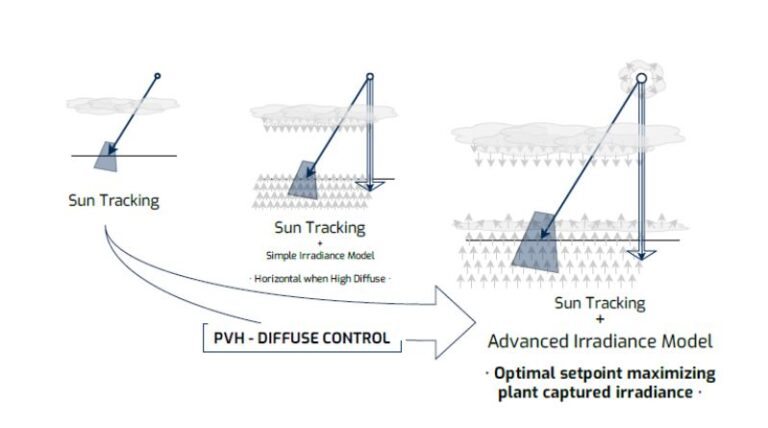PV Hardware USA has developed a solar tracker algorithm to improve energy collection in cloudy conditions. The algorithm could improve yields by as much as 20% on some days compared to traditional sun tracking methods.
A new solar tracker algorithm developed by PV Hardware USA can increase energy collection during cloudy conditions, potentially by as much as 20% on some days compared to traditional sun tracking algorithms.
Traditional solar tracker technology allows solar panels to generate some electricity in cloudy weather, but not enough to maintain light on sunny days. The Diffuse Control algorithm is designed to minimize motor energy consumption and maximize radiation captured in cloudy weather.
Diffuse Control determines the optimal tilt angle of the panel to capture energy, using real-time weather data collected by sensors placed around the solar installation. The algorithm can be configured to minimize motor consumption during operation and reduce unnecessary energy consumption.
What makes Diffuse Control technology advanced, according to PV Hardware, is the irradiance model’s ability to interpret the level of diffuse irradiance (the solar radiation that comes from light scattered by the atmosphere). The AI algorithm is based on the typical meteorological year and uses a series of calculations based on the Global Horizontal Irradiance (GHI) and Direct Horizontal Irradiance (DHI) values to evaluate whether the plant will benefit from the Diffuse Control technology.
Most traditional solar tracking uses fix-stepping, where the trackers move gradually and slightly a fixed number of times throughout the day. PV Hardware said fix-stepping does not adapt to varying irradiation conditions and can involve a lot of unnecessary movement during cloudy weather conditions.
Instead of fix stepping, PV Hardware has developed Dynamic Step, an algorithm that analyzes the captured radiation and only updates the set point if the relative energy capture is profitable. This reduces motor movement, avoiding unnecessary motor movements and energy consumption.
According to PV Hardware, the combination of the Dynamic Step algorithm with Diffuse Control reduces motor consumption by 30% compared to conventional solar control.
“Using new models of how solar energy is captured, we now understand that measuring ambient irradiance is the best way to calculate the tilt angle of a panel during inclement weather,” said Oscar Cabrero, the electronics and controls manager of PV Hardware.
PV Hardware analyzed several irradiation models using empirical testing over several months to determine which model is most effective in improving energy production in cloudy weather. Here you can read more about the testing method and its results white paper.
Author: Rachel Metea
This content is copyrighted and may not be reused. If you would like to collaborate with us and reuse some of our content, please contact: editors@pv-magazine.com.


